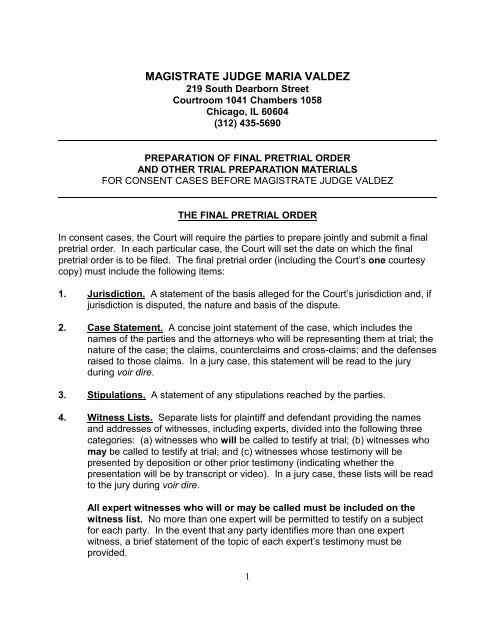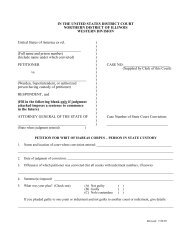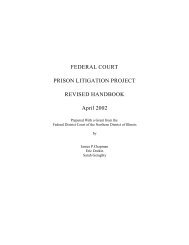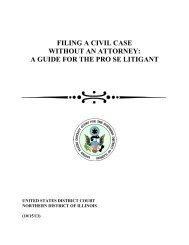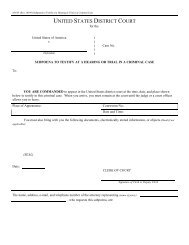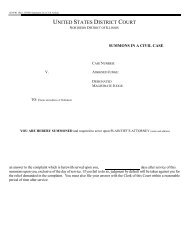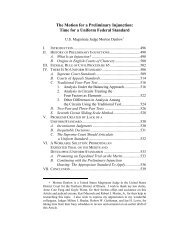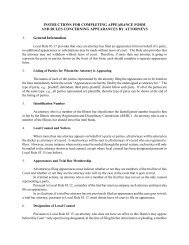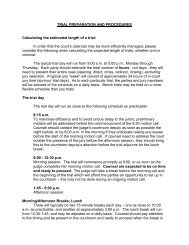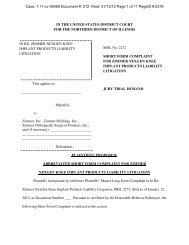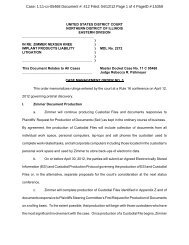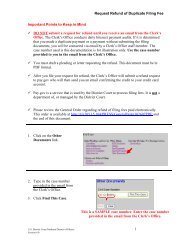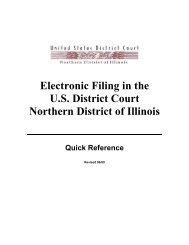Final Pretrial Order - Northern District of Illinois
Final Pretrial Order - Northern District of Illinois
Final Pretrial Order - Northern District of Illinois
Create successful ePaper yourself
Turn your PDF publications into a flip-book with our unique Google optimized e-Paper software.
MAGISTRATE JUDGE MARIA VALDEZ<br />
219 South Dearborn Street<br />
Courtroom 1041 Chambers 1058<br />
Chicago, IL 60604<br />
(312) 435-5690<br />
PREPARATION OF FINAL PRETRIAL ORDER<br />
AND OTHER TRIAL PREPARATION MATERIALS<br />
FOR CONSENT CASES BEFORE MAGISTRATE JUDGE VALDEZ<br />
THE FINAL PRETRIAL ORDER<br />
In consent cases, the Court will require the parties to prepare jointly and submit a final<br />
pretrial order. In each particular case, the Court will set the date on which the final<br />
pretrial order is to be filed. The final pretrial order (including the Court’s one courtesy<br />
copy) must include the following items:<br />
1. Jurisdiction. A statement <strong>of</strong> the basis alleged for the Court’s jurisdiction and, if<br />
jurisdiction is disputed, the nature and basis <strong>of</strong> the dispute.<br />
2. Case Statement. A concise joint statement <strong>of</strong> the case, which includes the<br />
names <strong>of</strong> the parties and the attorneys who will be representing them at trial; the<br />
nature <strong>of</strong> the case; the claims, counterclaims and cross-claims; and the defenses<br />
raised to those claims. In a jury case, this statement will be read to the jury<br />
during voir dire.<br />
3. Stipulations. A statement <strong>of</strong> any stipulations reached by the parties.<br />
4. Witness Lists. Separate lists for plaintiff and defendant providing the names<br />
and addresses <strong>of</strong> witnesses, including experts, divided into the following three<br />
categories: (a) witnesses who will be called to testify at trial; (b) witnesses who<br />
may be called to testify at trial; and (c) witnesses whose testimony will be<br />
presented by deposition or other prior testimony (indicating whether the<br />
presentation will be by transcript or video). In a jury case, these lists will be read<br />
to the jury during voir dire.<br />
All expert witnesses who will or may be called must be included on the<br />
witness list. No more than one expert will be permitted to testify on a subject<br />
for each party. In the event that any party identifies more than one expert<br />
witness, a brief statement <strong>of</strong> the topic <strong>of</strong> each expert’s testimony must be<br />
provided.<br />
1
All objections to the calling <strong>of</strong> any witnesses, and the reasons for the objections,<br />
must be stated in the pretrial order. For witnesses who will be presented by<br />
deposition or other prior testimony, the pretrial order must include for each such<br />
witness a chart containing the following information: (a) the testimony that each<br />
side seeks to present, by page and line; (b) a concise statement <strong>of</strong> objections to<br />
any testimony and the basis for the objection; and (c) a concise statement <strong>of</strong> the<br />
asserted basis <strong>of</strong> admissibility.<br />
5. Exhibit Lists. Lists <strong>of</strong> the trial exhibits (including demonstratives, summaries or<br />
other specially prepared exhibits), which are to be prepared in the following<br />
manner:<br />
A list <strong>of</strong> any joint exhibits, which states: (a) the exhibit number for the document<br />
(preceded by “JX”); (b) the date <strong>of</strong> the document; and (c) a brief description <strong>of</strong><br />
the document.<br />
Separate lists <strong>of</strong> plaintiff’s and defendant’s exhibits, which each state: (a) the<br />
exhibit number for the document (preceded by “PX” for plaintiff’s exhibits and<br />
“DX” for defendant’s exhibits); (b) the date <strong>of</strong> the document; (c) a brief<br />
description <strong>of</strong> the document; (d) whether there is a specific objection to<br />
admission <strong>of</strong> the document and, if so, a concise statement <strong>of</strong> the basis for the<br />
objection; and (e) a concise statement <strong>of</strong> the asserted basis <strong>of</strong> admissibility.<br />
In addition, one courtesy copy <strong>of</strong> all exhibits must be delivered to the<br />
Courtroom Deputy (Room 1036) on the date the final pretrial order is due.<br />
6. Estimate <strong>of</strong> Trial Time. A statement <strong>of</strong> whether the case will be a bench trial or<br />
jury trial, and a realistic estimate – in numbers <strong>of</strong> hours – <strong>of</strong> the length <strong>of</strong> the<br />
trial.<br />
7. Damage Itemization. An itemization <strong>of</strong> damages and other relief sought.<br />
8. Motions In Limine (including Daubert motions). A list <strong>of</strong> the titles <strong>of</strong> all<br />
motions in limine filed by each party. The actual motions in limine are not to<br />
be bound with the final pretrial order, but must be submitted separately<br />
according to the following schedule: If no briefing schedule has been set,<br />
motions in limine shall be filed no later than twenty-one (21) days before the<br />
pretrial order is to be filed and responses no later than fourteen (14) days before<br />
the pretrial order is to be filed. The parties are reminded that they must comply<br />
with the Local Rules <strong>of</strong> the <strong>Northern</strong> <strong>District</strong> <strong>of</strong> <strong>Illinois</strong> and this Court’s standing<br />
orders governing motions before filing any motions, including motions in limine.<br />
9. Proposed Voir Dire. The Court’s general voir dire questions can be obtained<br />
from the courtroom deputy. The parties must file in the pretrial order a joint<br />
2
document that includes both (a) each party’s proposed voir dire questions, and<br />
(b) each party’s objections, if any, to the voir dire questions proposed by other<br />
parties.<br />
10. Jury Instructions. The parties are instructed to meet and attempt to agree on<br />
jury instructions and to file proposed instructions with the pretrial order. The<br />
Court strongly believes that agreed instructions should be presented by the<br />
parties, and whenever possible, the parties are expected to agree on all<br />
instructions other than those about which there is a genuine, material dispute.<br />
The parties must file a joint document setting forth all agreed and proposed jury<br />
instructions as follows:<br />
• The joint document must set forth all proposed prefatory instructions,<br />
arranged in the order that the parties propose they be given. Copies <strong>of</strong><br />
the Court’s general pretrial instructions may be obtained from the<br />
courtroom deputy.<br />
• The joint document must set forth all instructions that the parties propose<br />
to be given at the close <strong>of</strong> trial, arranged in the order that the parties<br />
propose they be given.<br />
• Each proposed instruction must be identified at the top <strong>of</strong> the page by<br />
number, and must indicate the proponent <strong>of</strong> the instruction and whether<br />
the instruction is agreed or disputed (e.g., “Agreed Plaintiff’s Proposed<br />
Prefatory Instruction No. ____”; “Defendant’s Disputed Proposed <strong>Final</strong><br />
Instruction No. ____”). The bottom <strong>of</strong> each instruction must identify<br />
the legal authority supporting that instruction. If an instruction is<br />
disputed, the grounds for the objection (and any proposed modification or<br />
alternate instruction) must be concisely stated on the page immediately<br />
following the disputed instruction; on the next immediate page, the party<br />
proposing the instruction may state concisely the reasons supporting the<br />
instruction as proposed.<br />
• A “clean set” <strong>of</strong> all proposed instructions (i.e., unannotated instructions<br />
without party or numerical identification, legal authority, or legal argument)<br />
must also be provided.<br />
• In addition to hard copies, counsel shall furnish the Court with a CD<br />
containing the proposed jury instructions (both annotated and clean<br />
versions) in WordPerfect or Micros<strong>of</strong>t Word format.<br />
3
The above-referenced materials must be submitted with a cover document setting forth<br />
the case caption and the title FINAL PRETRIAL ORDER. The cover document: (a)<br />
must recite that each <strong>of</strong> the foregoing categories <strong>of</strong> materials is included; (b) after that<br />
recitation, must state that “This <strong>Order</strong> will control the course <strong>of</strong> the trial and may not be<br />
amended except by consent <strong>of</strong> the parties, or by order <strong>of</strong> the Court to prevent manifest<br />
injustice”; and (c) must provide spaces for the signature <strong>of</strong> counsel for each <strong>of</strong> the<br />
parties and by the Court. The parties are strongly encouraged to work together in<br />
drafting their <strong>Final</strong> <strong>Pretrial</strong> <strong>Order</strong>, and to come to agreement to the fullest extent<br />
possible.<br />
BENCH TRIALS: OTHER MATERIALS TO BE FILED BEFORE TRIAL<br />
! Proposed Findings and Conclusions. In a bench trial, proposed findings <strong>of</strong><br />
fact and conclusions <strong>of</strong> law are not to be included in the final pretrial order, but<br />
are to be separately filed (with one courtesy copy delivered to chambers) seven<br />
(7) calendar days before trial.<br />
! Trial Briefs. Trial briefs are not required in jury trials. The Court will advise the<br />
parties if a trial brief is required in a bench trial. Any party who has not been<br />
advised that a trial brief is necessary but who nevertheless wishes to file a trial<br />
brief must seek leave <strong>of</strong> the Court to do so.<br />
THE FINAL PRETRIAL CONFERENCE<br />
A final pretrial conference will be held as scheduled by the Court. At or by the pretrial<br />
conference, the Court will address pending motions in limine, objections to exhibits,<br />
objections to designations <strong>of</strong> depositions or other prior testimony, proposed voir dire<br />
questions and issue preliminary rulings on proposed jury instructions. The Court also<br />
will discuss with the parties trial procedures and scheduling, including a discussion on<br />
the prospect <strong>of</strong> settlement.<br />
The purpose <strong>of</strong> this conference is to avoid surprises and simplify the trial. Trial<br />
counsel, fully prepared, and with authority to discuss all aspects <strong>of</strong> the case,<br />
must attend.<br />
ENTER:<br />
October 4, 2012<br />
MARIA VALDEZ<br />
United States Magistrate Judge<br />
4


